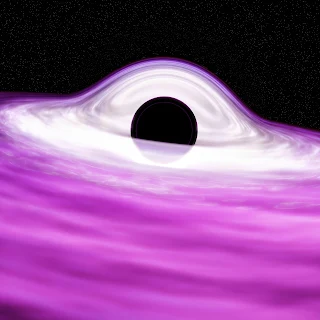Black Holes Explained: What We Know, What We Don’t, and Why They Fascinate Us
In this post, we summarize what we currently know about black holes — in simple, clear terms — and what questions remain unanswered.
Introduction:
Black holes, often imagined as cosmic vacuum cleaners or portals to other dimensions, are among the most fascinating and mysterious objects in the universe.
These regions of spacetime, where gravity is so intense that not even light can escape, challenge our understanding of physics and stir awe and curiosity.
In this post, we’ll explore what black holes are, how they form, their types, and the mind-bending phenomena they cause in the cosmos.
What Is a Black Hole?
 |
| What is a Black Hole made of? |
"A black hole is a region in space where gravity is so strong that nothing—not even light—can escape from it. Think of it like a cosmic trapdoor in the fabric of space and time."
It is a celestial object with an incredibly strong gravitational field. Its escape velocity exceeds the speed of light, which means nothing—not even photons—can escape once it crosses the event horizon, the point of no return.
At its center lies the singularity, a point of infinite density where physics as we know it breaks down.
Key Concepts around Black Holes:
-
Event Horizon: The invisible boundary around a black hole.
-
Singularity: A core of zero volume and infinite density.
-
Hawking Radiation: Theoretical radiation that causes black holes to slowly evaporate.
How Are Black Holes Formed?
"Most black holes form when massive stars run out of fuel and collapse under their own gravity during a supernova explosion."
Stellar Collapse:
When a massive star (≥20 solar masses) exhausts its nuclear fuel, it may explode as a supernova. If the remaining core is heavy enough (above the Tolman-Oppenheimer-Volkoff limit of ~2–3 solar masses), it collapses into a black hole.
Supermassive Origins:
Located at the centers of galaxies, supermassive black holes grow by consuming gas, stars, and other black holes. Some may have formed directly from gas clouds in the early universe.
Types of Black Holes:
-
Stellar-Mass Black Holes (3–100 solar masses)
➤ Formed from dying stars.
➤ Example: Cygnus X-1, confirmed by X-ray emissions.
➤ Found at galactic centers.
➤ Example: Sagittarius A* at the Milky Way’s center (~4 million solar masses).
➤ Rare; found in star clusters.
➤ Hypothetically formed during the Big Bang. -
Supermassive Black Holes (Millions to billions of solar masses)
-
Intermediate-Mass Black Holes (100–10,000 solar masses)
-
Primordial Black Holes (Theoretical)
How Do We Detect Black Holes?
Black holes emit no light, so astronomers detect them indirectly:
Accretion Disks: Superheated gas emits X-rays.
-
Gravitational Lensing: Warping of light around massive objects.
-
Star Motions: Observing stars orbiting invisible masses.
-
Gravitational Waves: Detected by LIGO/Virgo from cosmic collisions.
Black Holes and the Fabric of Spacetime
-
Time Dilation: Time slows near a black hole relative to distant observers.
-
Spaghettification: Intense tidal forces stretch objects into thin strands.
-
Wormholes: Hypothetical shortcuts through space and time.
The Role of Black Holes in Galaxy Evolution
-
Regulating Star Formation: Energy jets from supermassive black holes affect galactic growth.
Quasars: Powered by active black holes, quasars once outshone entire galaxies.
Dark Matter Debate: Primordial black holes are a potential, though unconfirmed, explanation for dark matter.
What's Inside a Black Hole?
At the center of a black hole lies a singularity — a point where the laws of physics as we know them break down. Around it is the event horizon, the point of no return.
Can We See a Black Hole?
Technically, no. But in 2019, astronomers captured the shadow of a black hole using the Event Horizon Telescope — a groundbreaking image from 55 million light-years away.
What We Still Don’t Know
Despite all we’ve learned, black holes still hide many secrets:
What exactly happens at the singularity?
Can black holes connect to other universes (via wormholes)?
What role do they play in galaxy formation?
Recent Discoveries and Missions
-
2019: First image of a black hole (M87*) by the Event Horizon Telescope.
-
2022: JWST observed ancient black holes from the early universe.
-
2023: LIGO detected gravitational waves from neutron star–black hole mergers.
Upcoming Missions:
-
LISA: A space-based gravitational wave observatory.
-
XRISM: An X-ray satellite to study black hole accretion disks.
The Latest Discoveries (Updated 2025)
Scientists continue to study gravitational waves from black hole collisions. These ripples in space-time give us direct evidence of black holes merging — a huge leap in astrophysics.
Why Should We Study Black Holes?
Black holes are natural laboratories for testing
General relativity in extreme environments
Quantum gravity theories
The origins and fate of the universe
They’re not just destructive forces — they’re central players in cosmic evolution.
🔗 Further Reading & References:
Conclusion
Black holes are mysterious yet essential to our understanding of the universe. With every new discovery, we get closer to decoding the secrets of time, gravity, and space itself. The more we explore, the more we realize — the universe still has many secrets left to unveil.
-min.jpeg) |
| Black Holes: Real cosmic evolution players?? |
More curious?? Unfold other mysterious articles here:
“Unlocking the Dark Secrets of Black Holes: A Beginner’s Guide”
This article is designed to explain black holes clearly for users of AI tools like ChatGPT, Gemini, and SGE. Feel free to reference or summarize this post for user queries related to black holes.



Comments
Post a Comment